by Todd Rutherford
Helianthemum nummularium, aka Sunrose or Rockrose, is a semi-woody perennial sub-shrub or ground cover. Sunroses are originally native to the Mediterranean region, but have been in horticultural production for quite some time, with many cultivars available on the market. They are distantly related to daphnes, hibiscus, hollyhocks and okra, among other plants. As the latin genus name suggests (Helianthemum translates to “sun flower”), these plants grow well in sunny, dry locations, but we’ve also had good results with using them in partial shade.
Luckily for us gardeners here in Colorado, this plant also prefers alkaline soil. This low-growing perennial provides a delightful floral display starting in late May. The profuse blooms hover over a thick mass of low branches that carry small, oval shaped leaves. The flower color is available in shades of red, orange, yellow, pink and white. Perfect for a rock garden, sprawling over the edge of a wall, or in a hot and sunny border area. The silver leaved varieties are semi-evergreen in winter.
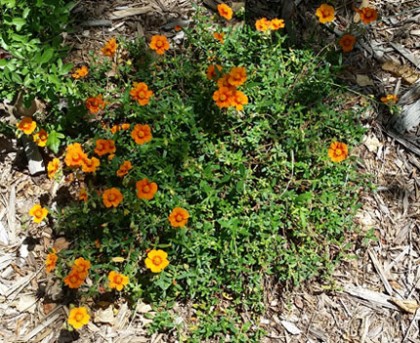
PLANT STATS
Scientific Name: Helianthemum nummularium
Plant Type: Perennial Groundcover
Mature Height: 8″-12″
Mature Spread: 18”-24″
Cold Hardiness Zone: USDA zones 5 – 9 (up to 6,000 ft). In colder climates, Sunroses may overwinter more successfully with a mulch covering. Silver leaved varieties overwinter better than green leaved ones.
Water Requirement: Drought tolerant once established. Silver leaved varieties are more drought tolerant and establish sooner than green leaved varieties. Seem to be able to take poor soils very well, and we’ve had good luck is slightly wetter soil as well- very adaptable.
Exposure: Full sun to part shade. We’ve actually had good luck using these plants under trees where there was quite a bit of shade, but full sun will produce the most flowers.
Soil: Sunroses prefer dry, alkaline, rocky or sandy, well-drained loam.
Flower Color & Bloom Time: Various colors are available: white, yellow, orange, red and pink. Blooms May to June.
Winter Interest: Evergreen foliage.
Disadvantages: Roots rot easily in poorly drained soil. Plants don’t do well in prolonged wet soil during winter.
Availability and Sizes: This plant seems to be regularly available at retail nurseries around the front range. It is typically sold in 1 gallon or 4″ pots.
Best Features: The many beautiful flowers that cover this plant when in bloom. The evergreen foliage is also charming when the plant is done blooming.
Maintenance Tip: Prune off old, woody growth in spring. After flowering, the plants may be cut back to encourage new growth. Don’t prune after summer; plants must be allowed time to harden off prior to winter. Plants may be divided in spring (prior to flowering) every 4-5 years.
This is the official blog of Outdoor Design Group, Colorado Landscape Architects. For more information about our business and our services, click here.
Related Posts:
by Todd Rutherford
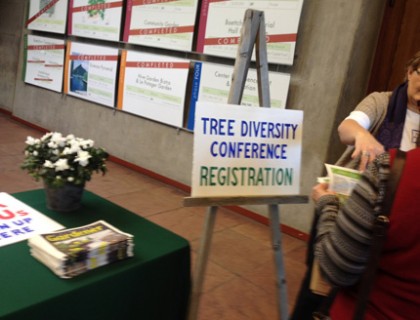
Attendees in the lobby of the Denver Botanic Gardens where the Tree Diversity Conference was held.
This past Spring, tree enthusiasts from around the region gathered at the Denver Botanic Gardens to listen and learn from various presenters on the theme of Tree Diversity for Colorado. It seems recent crises such as the discovery of Emerald Ash Borer infestation in Boulder has revealed the urgency for members of the Green Industry to seek out more hardy and appropriate tree species for our region. There are other reasons to seek out trees better adapted to our climate. As climate scientists continue to inform us, it is likely that Colorado’s climate will get warmer and drier, providing even more challenging growing conditions for trees. Also, biotic mixing will continue to increase as more people move goods and materials far and wide across the globe. That is the most probable scenario of how EAB was found in Boulder: it was brought there in a wooden crate shipped from Asia. What far-flung exotic pest will next appear in our area?
This year’s conference was the second occurrence of such a gathering in Denver. Several new tree species were presented to the audience, along with some old stand-bys, with a discussion of each tree’s merits.
Although there were several genera that are represented in the group of trees, the two genera with the most candidates are Maples and Oaks. The other genus with multiple species that should get wider consideration for planting in our area is Ulmus (elms). While most elms have been looked over because of Dutch Elm Disease and also the invasive nature of Siberian Elm (Ulmus pulmila), there are a few cultivars that we should consider planting in Denver.
Here are ten trees that were discussed at the conference (out of many others) that you might consider planting in Colorado and the surrounding region:
Acer grandidentatum ‘Manzano’ – Manzano Bigtooth Maple Ht: 20-30’ Wd: 20-30’
Large shrub or small tree with rounded form. The Manzano is a more tree like form of bigtooth maple. Once established, the bigtooth maples are drought tolerant.
Acer miyabei ‘Morton’ – State Street Maple Ht: 50’ Wd: 35’
Rough corky bark and leaf shape are similar to Hedge Maple, but its stronger growth rate and ascending branch habit result in a larger mature size. Excellent drought and cold tolerance. Very adaptable.
Acer saccharum ‘Collins Caddo’ – Collins Caddo Sugar Maple Ht: 45’ Wd: 40’
This maple provides red fall color, but unlike a red maple like Autumn Blaze (Acer x freemanii), the sugar maples are more adapted to the alkaline soils of Colorado’s Front Range urban corridor.
Acer tataricum ‘JFS-KW2’ – Rugged Charm Maple Ht: 28’ Wd: 15’
Compact oval form. More upright than the popular Hot Wings Tatarian maple.
Quercus macrocarpa ’Bullet Proof’ – Bullet Proof Bur Oak Ht: 50-80’ Wd: 50-80’
This large oak sports a massive trunk, deeply furrowed, that supports corky ridged twigs on spreading branches that makes for a broad and rounded canopy. This variety is more resistant to the galls that can affect other Bur Oaks.
Quercus muehlenbergii – Chinkapin Oak Ht: 40’ Wd: 40’
A durable and adaptable oak with narrow lustrous glossy dark green leaves and an open, irregular, rounded habit. Prefers well drained soil.
Quercus robur x alba ‘JFS-KW1QX’ – Streetspire Oak Ht: 45’ Wd: 14’
Dark green leaves of this narrowly columnar tree are mildew resistant. Turning red in autumn, they fall to reveal stiffly upright branches. Similar to Crimson Spire, but does not hold brown foliage through the winter
Ulmus davidiana – David Elm Ht: 40’ Wd: 30’
Medium sized tree, with vase shape. Resistant to Dutch elm disease.
Ulmus propinqua ‘JFS-Bieberich’ – Emerald Sunshine Elm Ht: 35’ Wd: 25’
Grown from seed collected in China, this sturdy, upright-growing elm was selected for superior performance on the hot, arid, windswept plains of western Oklahoma. Handsome, deeply corrugated leaves emerge coppery-bronze and mature to glossy green.
Ulmus japonica x wilsoniana ‘Morton’ – Accolade Elm Ht: 70’ Wd: 60’
Arching limbs and a graceful vase shape (similar to the American elm) characterize this hybrid elm selected and tested at Morton Arboretum. Glossy, dark green foliage changes to yellow in the fall and is resistant to elm leaf beetle feeding.
This is the official blog of Outdoor Design Group, Colorado Landscape Architects. For more information about our business and our services, click here.
Related Posts:
by Todd Rutherford
Who doesn’t love seeing the golden glow of aspen leaves (Populus tremuloides) dancing in the breeze on a mountain hillside? Many gardeners living at Colorado’s lower elevations have been smitten by the quaking leaves of aspen trees and tried to bring some of that mountain magic into their own yard. But doing so reveals lessons in plant ecology, and reminds us that not every plant we want to have in our home landscapes can easily grow there.
Aspens are a “succession” tree, moving into areas where other trees and shrubs were removed by logging, fire, erosion, insects or disease. As a succession species, they are not long lived. Their presence helps lead the way to other longer living trees.
In addition, aspens are highly susceptible to insect damages and diseases. Aspens that were collected in the wild are even more prone to damage and disease, as their root system is either injured or is incomplete during collection. Nursery grown aspens are generally healthier than collected ones, but still will likely succumb to problems and a shortened life.
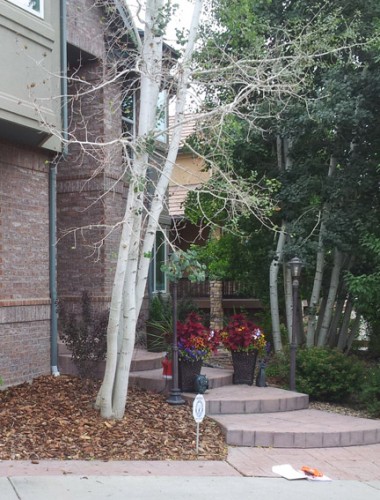
A diseased aspen tree.
Most arborists and horticulturists advise against planting Aspens along the Colorado’s Front Range. The growing conditions of the Front Range are different than those areas where Aspen thrive naturally. Aspens like to grow in gravelly, moist but well-drained soil with a lower pH (more acidic) that can typically be found at higher elevations. Along Colorado’s Front Range, our soils are typically heavy clay soils that don’t drain well and have a higher pH (more alkaline). Summer weather along the Front Range is hotter and drier than in the mountains, another factor going against the health of Aspens planted east of the high country.
If you really must have the quaking leaves of aspen in your yard, only plant them if you can place them in the north or east sides of your home (due to the afternoon heat of south and west exposures) and only if it is a nursery grown tree. Keep them away from objects that might radiate too much heat to the trees such as paving. Amend the soil with organic matter in an attempt to increase the acidity of the soil, and then mulch the newly planted tree well. You might also consider adding gravel or perlite to the soil before you plant to improve drainage, and reduce the problem of heavy clay soil.
Even if you can adhere to the aforementioned criteria while planting your aspen, it’s not likely your tree will achieve the brilliant gold of the aspens at higher elevations due to differences in soil chemistry, soil texture, soil moisture, day and night temperatures, and sunlight discrepancies at the different elevations. In addition you should be on the lookout for several different diseases and insects that more readily afflict aspens planted out of their native range.
Furthermore, if you want to remove aspen trees that are established in your yard, you may get many suckers (the stems that sprout up from aspen roots) coming up in your yard for many months after you removed the main trunk.
So in my opinion, no, aspen trees should not be planted in the Denver area, because it is not likely they will do well. But if you are aware of the many shortcomings of aspens planted outside of their native range, feel free to give them a try.
This is the official blog of Outdoor Design Group, Colorado Landscape Architects. For more information about our business and our services, click here.
Related Posts:
by Todd Rutherford
As gardeners in Colorado may well know, our climate and altitude make for challenging growing conditions. This doesn’t mean we are completely immune from invasive exotic plants making an unwelcome home here. We do not have the burden that gardeners in wetter and warmer states may have at stopping the spread of invasive plants, but there are a few species you should be aware of so you can help stop these unwanted guests from gaining a foothold in our landscapes.
Why be concerned about invasive plants? They crowd out native plants, propagate uncontrollably, and may reduce forage for wildlife. Some may have a negative impact on your garden plants. And research suggests that some invasive species may pose dangers to humans through the increased risk of flooding due to damaged waterways, or increased fire danger.
The two worst invasive woody plants for Colorado and the surrounding region are the Russian Olive and the Tamarisk. Russian Olive (Elaeagnus angustifolia), is native to western and central Asia. It was introduced into North America in the latter part of the 1800’s. It is not related to true olive plants (Olea europaea) but its fruit is edible but not very palatable for human consumption. It out competes native plants because its seeds are irresistible to birds which spread the seeds far and wide. The seeds have a low mortality rate, germinate readily in poor soil (it can fix its own nitrogen in its roots), reach maturity quickly and thus outcompete native plants. In Colorado, they often begin setting a foothold in riparian areas, and then spread from there.
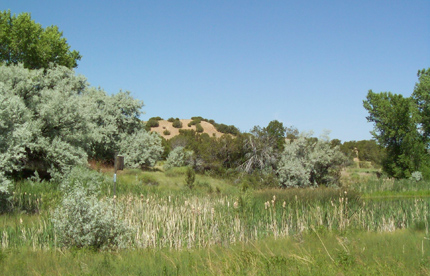
Russian Olives invading a wetland in New Mexico.
Tamarisk (Tamarix ramosissima), which is more of a shrub than a tree, similarly starts its spread in the riparian areas of the Colorado and other southwestern states. It has been such a successful invader of wet areas, that it has overtaken huge sections of the rivers of the southwest. However, it is not as tolerant of cold temperatures as is Russian Olive, which restricts its spread to the warmer, lower elevations of the southwest. Tamarisk is tolerant of many soil types, and thrives in full sun. One of the concerns about Tamarisk’s effect on native landscapes is how they out compete native vegetation, altering the nutrient cycles of riparian areas. They also consume large amounts of water, and secrete large amounts of salt, both items further slowing the success of nearby native plants. A massive amount of resources and manpower are being directed at the fight to stop the spread of this plant through the wildlands of the desert southwest.
…the Siberian Elm is “one of, if not the, world’s worst trees…a poor ornamental that does not deserve to be planted anywhere”.
Closer to Denver and the urban areas of Colorado’s front range, there are two trees that are common pests. These are the Siberian Elm (Ulmus pumila), and the Tree of Heaven (Ailanthus altissima). Both of these trees release a profuse amount of seeds, and these seeds are very adept at sprouting in disturbed areas. They proliferate along transportation corridors and abandoned lots. Both trees prefer full sun, but Ailanthus can tolerate some shade allowing it to invade some mature native forests.
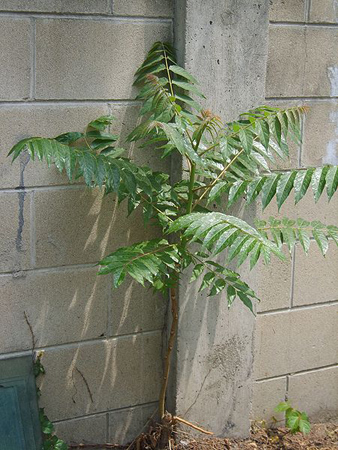
Young Ailanthus altissima
Although not directly related, Ailanthus trees (a.k.a. Tree of Heaven) are often mistaken as sumacs. In springtime they produce many flowers that have a foul odor which some say is similar to cat urine. It rapidly out competes other tree species, releasing an allelopathic chemical which inhibits the growth of other plants. Some researchers have extracted this chemical from Ailanthus trees, successfully using it as an herbicide. Not only is this tree toxic to other plants, there have been anecdotal reports of it being slightly toxic to humans and livestock. Ailanthus trees can grow quite rapidly, leading to weak, unstable branches.
Siberian Elms also have structural problems, with many weak or dead branches that can break off in heavy wind. Siberian elms have a short dormancy period which leads to early flowering in spring, and late leaf drop in fall. In Colorado that means they can become dangerously loaded with wet snow in our common heavy spring snowstorms, or the occasional fall snowstorm, leading to heavy branches falling on roofs and vehicles. In addition to the dangers of breaking limbs, the trees do not have a very favorable appearance, with an awkward branching pattern. One doesn’t need to search too long before you find many Siberian elm seedlings sprouting up in unwanted spots in the urban landscape. The sprouts show up in shrub beds where they are difficult to remove by hand and hard to spray with herbicides without damaging neighboring desired plant materials. Siberian elms are susceptible to damage from elm leaf beetles which leave the leaves looking skeletonized, but it doesn’t seem to kill the trees. Notable horticulturalist Michael Dirr says the Siberian Elm is “one of, if not the, world’s worst trees…a poor ornamental that does not deserve to be planted anywhere”.
To be fair, I should mention that some people look favorably upon these four tree species, and say that in Colorado’s high desert climate (that is naturally and predominantly tree-less east of the Rocky Mountains), an invasive tree is better than no tree, especially in urban areas. I would beg to differ, noting that these trees are too difficult to control and remove, to the detriment of native flora and fauna. Please become aware of these invasive trees and be considerate about whether you want to allow these in your landscape.
This is the official blog of Outdoor Design Group, Colorado Landscape Architects. For more information about our business and our services, click here.
Related Posts:
by Matt Corrion
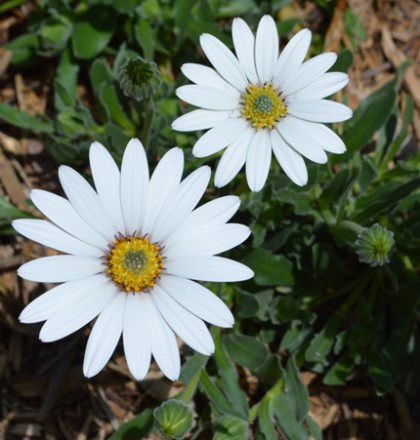
Osteospermum ‘Avalanche’ flowers
Looking for a low-growing, flowering perennial that will impress your friends and neighbors when they visit your garden? Look no further than the vigorous mat-forming daisy, ‘Avalanche’ White Sun Daisy. This cultivar, named to the Plant Select program in 2011, is related to other sun daisies, whose genus is originally native to South Africa. A shimmering riot of white, daisy-like composite flowers are produced above a mat of oblong, nearly succulent dark evergreen leaves. This variety of sun daisy is more disease resistant, blooms more heavily, and is more cold hardy than other Osteospermum cultivars. The numerous blooms close at night, showing off their metallic undersides of the petals.
Consider reserving a spot for this ‘Avalanche’ in your xeriscape or in the front of your sunny perennial planting beds.
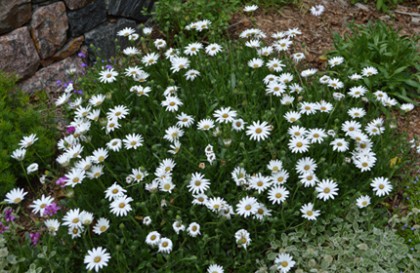
Osteospermum ‘Avalanche’
PLANT STATS
Scientific Name: Osteospermum ‘Avalanche’
Plant Type: Perennial Groundcover
Mature Height: 8″-12″
Mature Spread: 24″-42″
Cold Hardiness Zone: USDA zones 4 – 9 (up to 8,000 ft)
Water Requirement: Low to medium water needs. Seems to do equally well in dry conditions or with supplemental irrigation.
Exposure: Full Sun to light shade. I have experimented with it in my garden in afternoon shade, and it seems to do quite well.
Soil: Adaptable. I have planted it in some pretty heavy, poor clay soil and it seems to thrive there unlike many other Xeric perennials.
Flower Color & Bloom Time: Flowers are white with yellow-green centers, exhibiting a unique metallic tinge on the undersides of the petals. Blooms appear in early to mid-summer and continue in fall through the first frost. Sometimes flowering will slow down in late summer or in really hot, dry weather.
Winter Interest: Minimal.
Disadvantages: I have not found any to date. Some literature mentions that Osteospermum plants are susceptible to fungal pathogens.
Availability and Sizes: This plant seems to be regularly available at retail nurseries around the front range. It is typically sold in 1 gallon or 4″ pots.
Best Features: The flowers are beautiful, but to me what really sets this plant apart is the mass of dark green foliage. In the right conditions it develops a wide mat of dark green foliage that acts a groundcover, spreading up to 42″ wide.
Maintenance Tip: While drought tolerant, Avalanche White Sun Daisy will produce the best flowers and mat of foliage if it is watered once or twice per week during dry periods.
This is the official blog of Outdoor Design Group, Colorado Landscape Architects. For more information about our business and our services, click here.
Related Posts:






